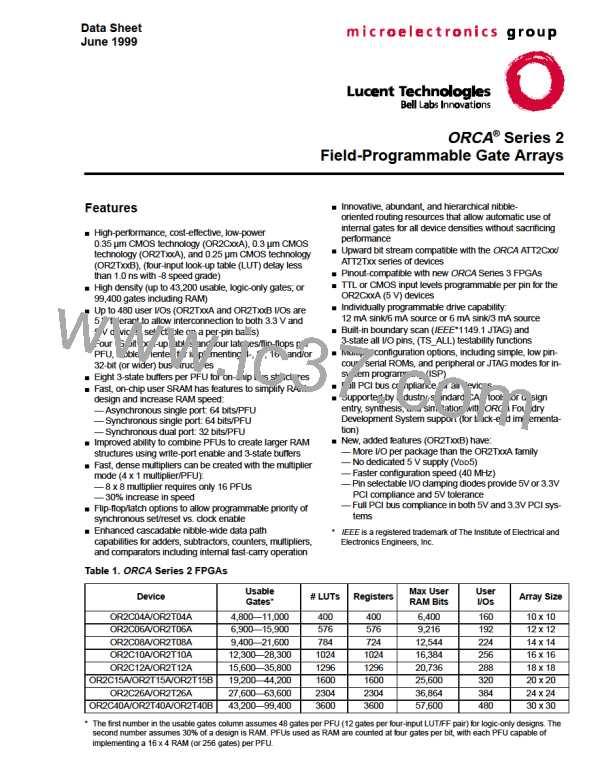Data Sheet
June 1999
ORCA Series 2 FPGAs
Programmable Logic Cells (continued)
INDEPENDENT CIP
PLC Routing Resources
B
CD
=
Generally, the ORCA Foundry Development System is
used to automatically route interconnections. Interac-
tive routing with the ORCA Foundry design editor
(EPIC) is also available for design optimization. To use
EPIC for interactive layout, an understanding of the
routing resources is needed and is provided in this sec-
tion.
A
A
B
MULTIPLEXED CIP
CD
2
O
The routing resources consist of switching circuitry and
metal interconnect segments. Generally, the metal lines
which carry the signals are designated as routing
nodes (lines). The switching circuitry connects the rout-
ing nodes, providing one or more of three basic func-
tions: signal switching, amplification, and isolation. A
net running from a PFU or PIC output (source) to a
PLC or PIC input (destination) consists of one or more
lines, connected by switching circuitry designated as
configurable interconnect points (CIPs).
A
B
C
A
B
C
O
f.13(F)
Figure 19. Configurable Interconnect Point
3-Statable Bidirectional Buffers
The following sections discuss PLC, PIC, and interquad
routing resources. This section discusses the PLC
switching circuitry, intra-PLC routing, inter-PLC routing,
and clock distribution.
Bidirectional buffers provide isolation as well as amplifi-
cation for signals routed a long distance. Bidirectional
buffers are also used to drive signals directly onto
either vertical or horizontal XL and XH lines (to be
described later in the inter-PLC routing section). BIDIs
are also used to indirectly route signals through the
switching lines. Any number from zero to eight BIDIs
can be used in a given PLC.
Configurable Interconnect Points
The process of connecting lines uses three basic types
of switching circuits: two types of configurable intercon-
nect points (CIPs) and bidirectional buffers (BIDIs). The
basic element in CIPs is one or more pass transistors,
each controlled by a configuration RAM bit. The two
types of CIPs are the mutually exclusive (or multi-
plexed) CIP and the independent CIP.
The BIDIs in a PLC are divided into two nibble-wide
sets of four (BIDI and BIDIH). Each of these sets has a
separate BIDI controller that can have an application
net connected to its TRI input, which is used to 3-state
enable the BIDIs. Although only one application net can
be connected to both BIDI controllers, the sense of this
signal (active-high, active-low, or ignored) can be con-
figured independently. Therefore, one set can be used
for driving signals, the other set can be used to create
3-state buses, both sets can be used for 3-state buses,
and so forth.
A mutually exclusive set of CIPs contains two or more
CIPs, only one of which can be on at a time. An inde-
pendent CIP has no such restrictions and can be on
independent of the state of other CIPs. Figure 19
shows an example of both types of CIPs.
Lucent Technologies Inc.
17

 ETC [ ETC ]
ETC [ ETC ]